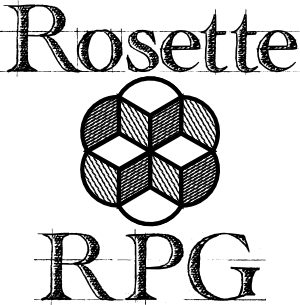 A big secret of tabletop RPG design is that roleplaying games play themselves. Get the right group of people together and they’ll have fun telling a good story, regardless of which edition of which game they’re playing. The hard parts of RPGs are things the designer can’t control: social dynamics.
A big secret of tabletop RPG design is that roleplaying games play themselves. Get the right group of people together and they’ll have fun telling a good story, regardless of which edition of which game they’re playing. The hard parts of RPGs are things the designer can’t control: social dynamics.
What good are rules at all, then? Rules serve two purposes: to enable and constrain the play. The rules of an RPG serve to make the creative process easier by enabling story, and they constrain the scope of the story to keep the group within a manageable narrative space.
In my role as lead designer on Future Proof Games‘s upcoming tabletop RPG Rosette1, I’ve made tons of decisions regarding how the rules work. By the request of one of my patrons, I’ll go over that process from a high level.
Where the Rules Live
There are several rough categories you could fit rules into. There are character creation rules, which help to inspire and shape a character and provide mechanical2 hooks for the character’s story traits. There are conflict resolution rules, which answer the basic question, “How do you tell if a character succeeds at an interesting task3?” There are special encounter rules, such as combat, which typically form a little sub-game that can be more strategic than the general ruleset. Finally, there are narrative rules, which govern how players and the GM can introduce story elements in a rule-based way.
Not all games have each type of rules, and different games focus on different things. The newer style of “indie RPGs4” tends to have little or no combat system and far more narrative control (sometimes not even assigning the role of GM), while old-school Dungeons and Dragons and similar games have virtually no narrative rules beyond “what the GM says happens happens.”
When making these rules, the designer has a broad toolbox. She can assign statistics to certain traits and make players do math on them; this allows for differentiation of characters and situations and makes it easier to guess probable outcomes. She can leave certain outcomes up to chance, usually based on a die roll but sometimes based on card pulls or even games of Rock, Paper, Scissors; this adds tension to situations and allows the story to develop in unexpected ways. She can involve resources, where certain events or choices cause a character or player to gain or lose qualities or points; this shapes the progression of the story or pushes players to make interesting choices that trade risk and reward.
Muses and Boxes
You could run an RPG without any rules at all. I’ve done it; in college I ran a years-long campaign called Slowdream where players made whatever characters they wanted. Characters succeeded at things they were good at and I guided the course of the story by feel. What the rules provide is structure: support to keep things moving and guidelines to keep things on track.
Rules serve as an inspiration by enabling story. Dungeons and Dragons provides a collection of fantasy races (species) and classes (jobs) that help players come up with cool character concepts. A player that struggles when told to “create any fantasy character” might come up with tremendously creative concepts when inspired by the idea of a “gnome barbarian” or a “dwarf monk.” Likewise, the fact that the Shadowrun rules depend heavily on money pushes the story toward performing jobs for wealthy corporate backers.
Rules also constrain story, keeping it within expected bounds. When you play Vampire: the Requiem you want to explore darkness and complex morality; the rules support this by making it difficult to play an isolated homebody or a flashy superhero. A game of My Life with Master is supposed to end in pitchforks and fire, and the rules ensure this through their bleak-but-hopeful exchange of statistics like Love and Weariness.
This is the balance of RPG design. Shove the story in a direction, but use constraints to keep it from going too far.
Quirky Case Study
Let’s look at an example from Rosette to see how all this works in practice. Rosette is intended to provide “quick, creative collaboration.” As part of this, players need a mechanical way to influence the story by featuring their character’s idiosyncrasies in a way that doesn’t slow the game down.
Rosette characters have up to five quirks: a concept borrowed from GURPS to represent notable features of a character that aren’t covered by more general statistics. A character might have Calm Facade, Caring, Driven, Simple Clothes, and Traumatized. I wanted to make these quirks come up in play, in the same way that Commander Sisko’s love of baseball helps him communicate with aliens or Hamlet’s mourning melancholy lets him disguise his plotting as madness.
Rosette‘s conflict resolution happens through a roll of two dice, with the player hoping to roll as high as possible. To encourage the player to bring quirks into play, I chose to let the player use a quirk to roll a third die to improve their results. This lets players affect the outcome of a chance-based situation when it has narrative weight relevant to the character.
In order to constrain the frequency by which character traits come into play, to keep the game from becoming a litany of quirks, each quirk may only be used once per game session. Players therefore have to choose whether a situation is important enough to expend their limited resources on.
As a way of inspiring better story, quirks can be used in three different ways. They can be Highlighted, where a character demonstrates their quirk to influence a situation. They can be Defied, where a situation pushes a character to overcome a foible or betray their values in order to accomplish a task. Finally, they can be Introduced, where a situation that appeared unrelated to a quirk is revealed to be relevant.
The last option, Introduction, lets players guide the story by adding details that make it fit their characters better. This inspiration can shape the GM’s story in unexpected ways and gives the players a way to implicitly tell the GM what kind of story they want to tell.
RPGs Play Themselves
A well-suited group of players can make a good RPG experience out of any ruleset through their natural creativity and social synergy. The role of the game’s rules, then, is to encourage that experience by fueling and shaping the story. I designed the quirks system in Rosette to serve this purpose.
Quirks encourage players to highlight their characters’ less mechanical aspects in the service of their greater challenges. However, their use is constrained to discourage more assertive or goal-oriented players from claiming too much attention to their own characters’ foibles at the cost of the rest of the characters.
Every game designer, whether they realize it or not, is going through this process. Enabling story, constraining story. Pushing and pulling. As an exercise, take a look at a rule in a game that you never considered, and ask yourself: what was the intent behind this rule? You might learn something about the shape the designer wanted for the game.
This article was commissioned by a patron. To support my work, sign up for my Patreon and help me continue producing writing like this.
